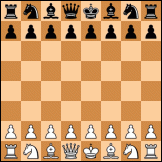
Links:
http://en.wikipedia.org/wiki/El_Ajedrecista
http://en.wikipedia.org/wiki/Leonardo_Torres_y_Quevedo
http://blog.modernmechanix.com/2006/03/ ... -opponent/
Moderator: Ras





Code: Select all
[Event "Unknown event"]
[Site "Unknown site"]
[Date "2012.01.05"]
[Round "-"]
[White "Unknown player"]
[Black "Unknown player"]
[Result "1-0"]
[FEN "7K/8/8/8/8/8/2k5/1R6 w - - 0 1"]
1 Ra1 Kb2 2 Ra8 Kc2 3 Ra3 Kb1 4 Kg7 Kb2 5 Rg3 Kc1 6 Kf6 Kc2 7 Ke5 Kb2 8 Kd4 Kc2 9 Ra3 Kb2 10 Rc3
Ka2 11 Kc4 Kb2 12 Kb4 Ka2 13 Rb3 Ka1 14 Kc3 Ka2 15 Kc2 Ka1 16 Ra3# 1-0
I have a signed photo of Claude Shannon with a KRK machine he developed in the 1950's... I was not aware there was one done earlier... Shannon's is based on relays and such, not mechanics.Ajedrecista wrote:Hello:
I have searched in a Spanish newspaper archive (ABC) and there is an article (written in Spanish, of course) dated on 25th March, 1953, with an improved version of El Ajedrecista. Links:
http://hemeroteca.abc.es/nav/Navigate.e ... 5/015.html
http://hemeroteca.abc.es/nav/Navigate.e ... 5/017.html
The first photograph (attached with a bunch of drawings) shows the complexity inside the machine, while the second is an exterior view.
The article begins with a brief review of older machines, continues with the inner workings of El Ajedrecista and finishes explaining the output of the moves while recognizing the huge merit of Torres Quevedo. Please enjoy!
Regards from Spain.
Ajedrecista.

I saw a photograph of Shannon's electromechanical chess endgame computer, printed in Adventures in Chess by Edward Lasker. The machine was about the size of a large footstool. The playing board was about 30 cm on a side and it looked like each square had a switch and a lamp. The report by Lasker is that Shannon's machine could handle endgames with up to six men.bob wrote:I have a signed photo of Claude Shannon with a KRK machine he developed in the 1950's... I was not aware there was one done earlier... Shannon's is based on relays and such, not mechanics.


Wrong! Sorry for the miss-information. I re-read the paper in the Computer Chess Compendium and found nothing about 63 moves, but Levy mentioned in the chapter foreword less than 50 moves. I don't know where I read the 63 somewhere, its still from the early cpw times I did not used references and quotes carefully.Gerd Isenberg wrote: According to Henri Vigneron it could take up to 63 moves until mate.
guess we need to implement the algorithmAus der ungünstigsten Stellung erfordert die Mattführung gegen bestes Gegenspiel etwas über 60 Züge, was nach den FIDE-Regeln remis durch Überschreiten der Fünfzig-Züge-Grenze wäre.
I believe that "6 man ending" statement was in error. I talked to Claude Shannon when he gave me this photo and he was emphatic that it was a KR vs K and that it would always mate with the rook, although not always "optimally".sje wrote:I saw a photograph of Shannon's electromechanical chess endgame computer, printed in Adventures in Chess by Edward Lasker. The machine was about the size of a large footstool. The playing board was about 30 cm on a side and it looked like each square had a switch and a lamp. The report by Lasker is that Shannon's machine could handle endgames with up to six men.bob wrote:I have a signed photo of Claude Shannon with a KRK machine he developed in the 1950's... I was not aware there was one done earlier... Shannon's is based on relays and such, not mechanics.
I would dearly like to get the schematic. Was Shannon working for Bell Labs at the time? Maybe the machine is still intact and is sitting in a storeroom somewhere in Murray Hill.
I have a link to a surplus electronics store that sells the relays that were used in telephone switching offices prior to the Transistor Age. These relays can be had by the thousand at only US$0.25 each, so it might not be too expensive to re-create the machine and perhaps add some improvements.